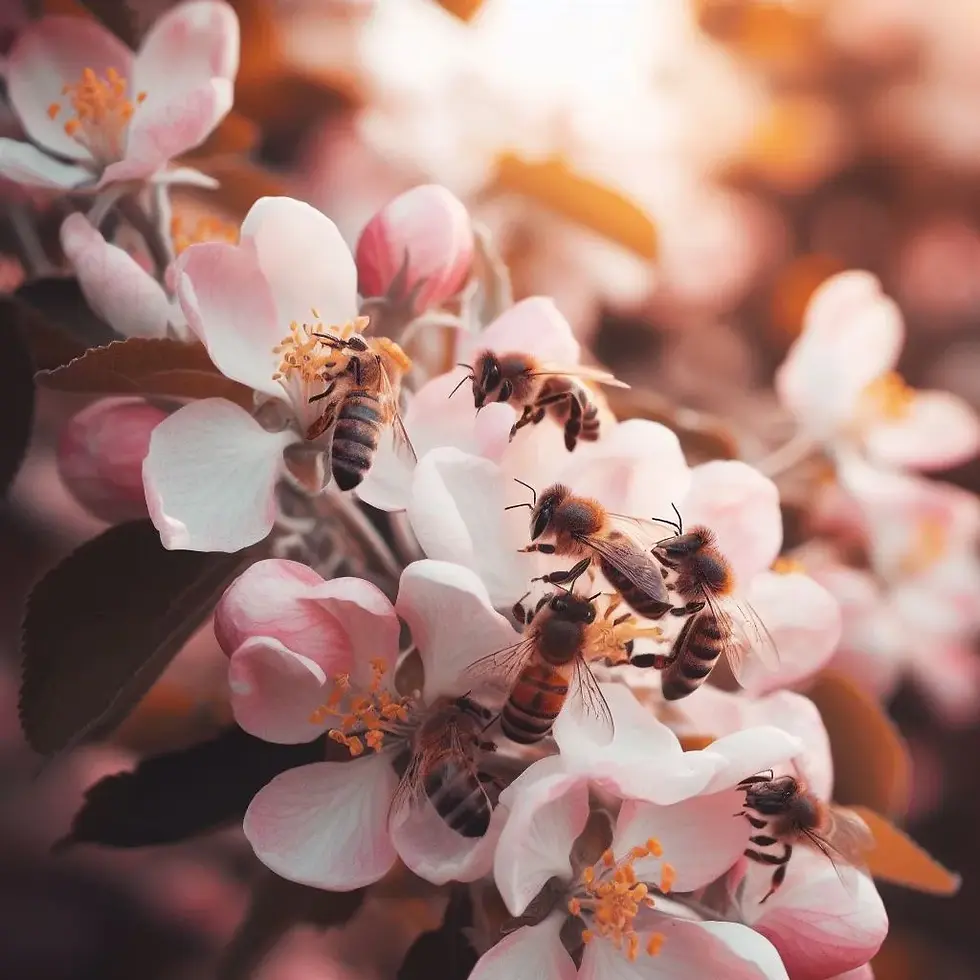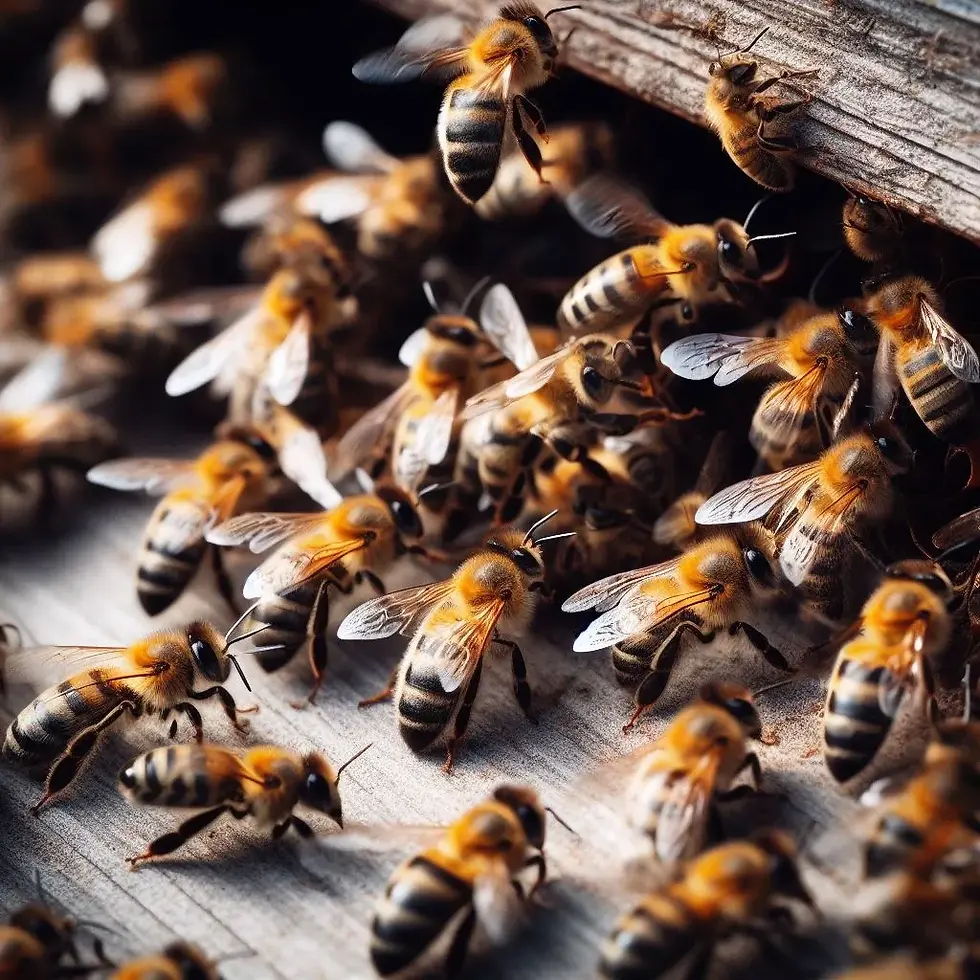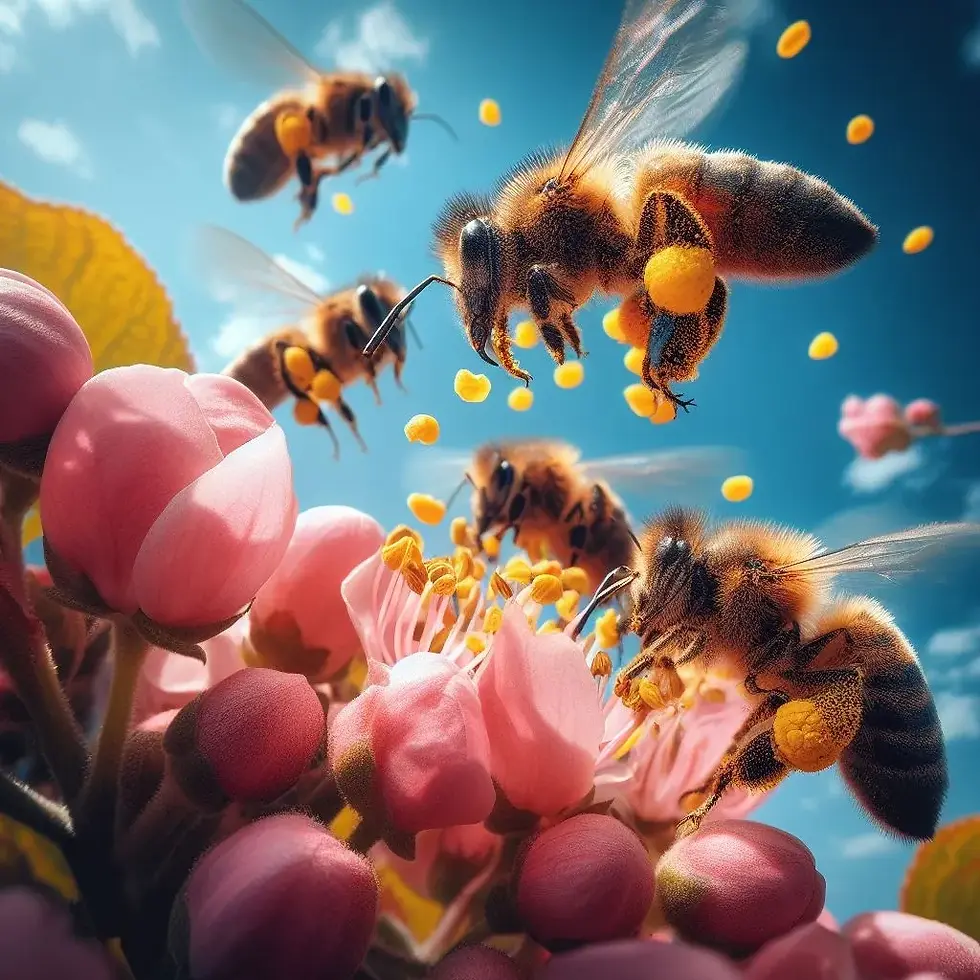Honey Bees: The Workforce Behind California Almonds
- Pete Rizzo

- Jan 3, 2024
- 7 min read
Updated: Oct 28

Almond Pollination Heroes: The Honey Bee, Beekeepers, and Growers Roles
Each February, California becomes the stage for one of nature’s greatest migrations, a spectacle rivaling the wildebeest crossing of the Serengeti.
Betsy and I from Vegas Bees will be there to witness it firsthand.
Millions of honey bees awaken from winter’s chill and begin their journey to California’s vast almond orchards, where growers anxiously await their arrival.
For a few short weeks, these tiny pollinators will bring the orchards to life, transforming acres of bare trees into a sea of pink and white blossoms.
This incredible event sustains the state’s billion-dollar almond industry, yet it all hinges on a fragile partnership between beekeepers and farmers.
Success depends not only on timing and coordination, but on the health and resilience of the bees themselves.
I’ll explain the role honey bees play in almond pollination, the behind-the-scenes logistics that make it possible, and the careful management required to keep colonies strong during this demanding season.
We’ll also discuss the broader environmental implications of this event and recent advances that may improve sustainability.
When we peel back the layers of this phenomenon there are fascinating stories within almond pollination that link nature, agriculture, economics, and cutting-edge technology.
The Almond Industry and Its Dependence on Honey Bees
Almonds have evolved from a niche specialty crop into California’s most valuable agricultural commodity, driven by soaring domestic and international demand.
Almond milk alone is reshaping the dairy market, steadily claiming ground once dominated by cow’s milk.
Today, California produces more than 80 percent of the world’s almonds, exporting over $4.5 billion worth each year. At the heart of this global success story stands one indispensable partner: the honey bee.
Each spring, when almond trees erupt in soft pink and white blossoms, they rely entirely on insect pollination for roughly a month to set the nuts that define the coming harvest.
But with native bee populations in steep decline, that responsibility now falls almost entirely on commercial honey bees, millions of colonies transported from every corner of the country to California’s Central Valley.
Over a brief five-week window, these bees perform an astonishing feat: pollinating more than 80 billion almond blossoms through relentless flights from dawn to dusk.
Their contribution is so vital that pollination fees paid by almond growers can represent nearly half of a professional beekeeper’s annual income.
This brief but intense pollination season has become the single most important event linking the economic health of both the almond industry and American beekeeping.
It’s a partnership built on precision, timing, and the enduring resilience of honey bees.

The Logistics and Stresses of Bee Migration
Executing this mass migration of honey bee colonies is no small feat. It requires intricate planning, tricky timing, and strict coordination between growers and beekeepers.
In early February, the first leg of colonies begin converging from as far as Florida, New England, and the Dakotas.
Trucks stacked high with palleted hives make the multi-day haul to California, allowing time for the bees to acclimate once unloaded.
Beekeepers strategically stagger deliveries to align with the gradual almond bloom chronology across different growing regions.
Upon arrival, hives are scattered throughout the dormant orchards, with locations constantly shifting to surround new sections coming into bloom.
Motors roar and forklifts whirl nonstop, relocating hives under the cover of night when bees are safely clustered inside. It’s a logistical dance requiring military precision and flexibility.
Beekeepers also install fresh honey frames and pollen patties to help bees recover from transportation stress and launch into brood rearing.
Colonies must rapidly rebuild numbers to take advantage of the narrow 4-6 week bloom window before facing another multi-day return journey.
Bee Health and Management During Almond Tree Pollination
Ensuring honey bee health and safety during almond pollination presents a raft of challenges for beekeepers and growers alike.
Stressed bees tend to underperform, so maintaining vigor is paramount for effective pollination.
However, the huge influx of colonies intensifies the transmission of pests and pathogens. Varroa mites run rampant in the dense hive concentrations.
Deformed Wing Viruses, acute paralysis viruses, and Nosema parasites also plague struggling hives. The lack of genetic diversity likewise allows illness to spread like wildfire.
While pesticide exposure is a threat year-round, reports indicate elevated colony losses from the cumulation of spray applications just before bloom.
Certain fungicides like chlorothalonil are especially toxic to brood development and colony health. Coordinating with farmers to shift the timing or types of chemical applications can reduce impacts.
On top of these concerns, unpredictable weather events like extreme heat, flooding rainfall, or sudden frosts can devastate bees during critical spring bloom.
Advanced contingency preparation and active hive monitoring help mitigate issues.

The Impact of Climate Change on Almond Pollination
Climate change doesn’t just impact the weather - it’s also altering California’s seasonal clock, with profound implications for almond pollination.
Rising temperatures cause fluctuations in bloom timing year after year, hampering coordination efforts. Erratic chill hours and warmer winters likewise disrupt almond tree dormancy patterns.
Meanwhile, drought and reduced snowpack promote earlier bloom onset while limiting orchard access to water during this crucial developmental window.
Moisture stress then leads to reduced flower production for bees to collect from.
Modeling indicates climate shifts could cause the almond bloom to advance up to 3 weeks earlier by 2050.
These volatile conditions make planning and executing seamless bee migration patterns infinitely more complex. The future may necessitate new almond varietals with shifting bloom capabilities and drought tolerance to adapt to changing climate realities.
Economic Aspects for Beekeepers
The economics swirling around almond pollination hold staggering implications for the beekeeping trade. Pollination fees paid per contracted colony can infuse vital cash flow to cover operational costs after expensive winter preparations.
Rates fluctuate in response to hive inventory and farmer demand, ranging from $200-$275 in recent seasons.
With the average beekeeper shuttling 1600 hives to almonds, pollination payouts represent nearly 60% of annual income. This far eclipses the 25% generated from honey production or other revenue streams.
However, realizing full rental incomes depends on delivering robust, populous colonies. Weaker units see substantial deductions to account for reduced pollination capacity.
Hives lost to transportation incidents, vandalism, pesticide kills or colony collapse also represent major financial hits.
Despite the risks, most beekeepers consider almond pollination income the backbone for business survival. As demand escalates for healthy bee colonies, so too do pollination prices, making the event an increasingly essential economic engine.
The Role of Technology and Research
Realizing the full potential of honey bee contributions means leveraging science to navigate mounting environmental pressures.
Researchers are accordingly racing to provide solutions through major advances.
Precision technology like digital hive monitoring systems now delivers 24/7 insight into colony strength.
Temperature and humidity readings, plus built-in scales tallying honey stores, help assess supplement needs and pollination readiness.
Geographic Information Systems and predictive models now map real-time bloom status to improve transportation coordination.
Meanwhile, mapping bee health factors across the state highlights regional risks for avoiding pesticide incidents or disease outbreak epicenters.
Genomic research also works toward breeding honey bee strains that are more resilient against varroa mites, insecticides, and climate fluctuations - a key long-term adaptation strategy.
Together, these breakthroughs offer Dynamic solutions for overcoming growing environmental complexity.

Ethical and Environmental Considerations
Despite its indispensable role in almond production, migratory beekeeping faces criticism regarding ethics and broader ecosystem impacts.
Large- scale almond monoculture supports only a single flower source. Critics argue this provides a nutritionally inadequate, stressful diet lacking the diversity bees need to thrive long-term.
They contend reliance on this event pressures colonies and helps propagate collapsing populations.
Related is the question of overworking commercial bees pollinating crops across increasingly vast agricultural zones.
While almond farmers pay well for their services, some argue bees provide far more total value to food systems than they receive in return compensation.
Habitat loss in high-intensity farming regions also leaves bees few native forage options outside orchards, forcing confinement when not pollinating.
Supporting biodiversity through flowering field borders, hedgerows, and other forage could bolster nature’s pollinators region-wide.
Integrating more thoughtfully managed open spaces may help mitigate ethical issues. But the fact remains: until technology advances provide alternative solutions, the livelihoods of bees and almond growers will remain deeply intertwined.
Let's Sum It All Up
California Almonds represent a pinnacle of the intricate connections linking human agriculture and the natural environment.
This single event bears tremendous influence over global food systems and local economies alike due to our dependence on bees as catalysts for nut production.
Yet inherent risks abound from pests, pathogens, pesticides, and volatile weather patterns, all amplified by climate change realities.
Fortunately, expanding technology and research initiatives provide hope for overcoming these mounting pressures. The Almond Board of California should step in and help find answers to some of these pressing issues.
What’s certain is that almond growers and beekeepers must continue working in harmony to ensure ethical, sustainable livelihoods for both colonies and farmland.
The Central Valley in California has a great deal to lose without the bee's help.
While bees may not understand the concept of money, their role in lucrative almond orchards truly can’t be bought.
We will be there in February 2024 with more news and stories from the front lines of the beekeepers.
Betsy and Pete
Las Vegas, Nevada
About Us: The Authors

We’re Betsy and Pete - Beekeepers on a Mission in Las Vegas
We’re not just in the bee business, we’re in the bee-saving business. Trained by a master beekeeper and backed by hundreds of successful removals, we are dedicated to rescuing and relocating honey bees with care and precision.
Every swarm we save and every hive we manage reflects our deep love for the bees.
At our Joshua Tree Preserve in Arizona, we care for dozens of thriving hives. Some wild, some honey-bearing, and all are part of our commitment to ethical, sustainable beekeeping.
Why Vegas Bees? Because We Never Stop Learning or Caring
Beekeeping is always evolving, and so are we. We stay on the cutting edge by continuing our education, connecting with fellow beekeepers, and refining our beekeeping practices and techniques to ensure the best outcomes for both bees and people.
Whether it’s advanced bee removal strategies or the latest natural methods, we’re always one step ahead.
We’re also proud to support the beekeeping community with high-quality beekeeping supplies for everyone. If you’re ready to suit up and start your journey, we’ve got what you need.
.png)


